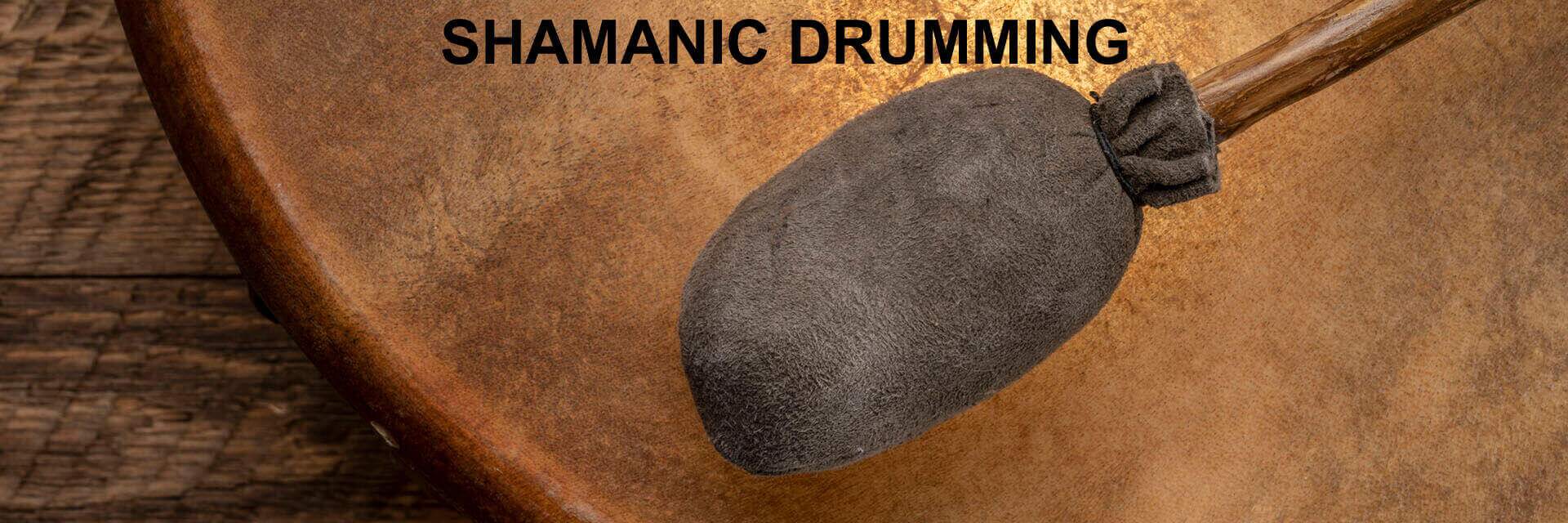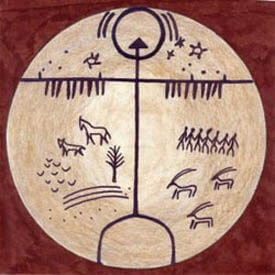


In the worldview of the shaman, all life forms are interconnected and interdependent. If one species suffers, all others are affected. The health and well-being of humanity is, therefore, dependent upon the overall health of the web of life. The shaman is sensitive to this sacred interrelationship and serves as an intermediary between nature and the community. The shaman's prayerful communion with the natural elements and powers preserves an orderly, harmonious universe. The shaman seeks harmony with nature and the drum serves as an instrument of attunement.
The drum has a role of first importance to the shaman, for its rhythm develops an oneness of feeling and purpose with the rhythms of the universe. The drum's beat unites the shaman with all life forms into a single being, a single heartbeat.
The drum also serves as a concentration device, enhancing the shaman's capacity to focus attention inward. It stills the incessant chatter of the mind, enabling the shaman to enter a subtle or light-trance state. "From the shaman's perspective, the drum is used to call on his or her helping spirits for entry into and support in the spirit world. The drumbeat also serves as an anchor, or lifeline, that the shaman follows to return to his or her body and/or the exit the trance state when the trance work is complete."1
The shaman traverses the inner planes in order to create and change experience and to help others do the same. It is an inward spiritual journey of rapture in which the shaman interacts with the inner world, thereby influencing the outer world. In the shaman's world, all human experience is self-generated. Experience is shaped from within since the three realms or resonant fields that define our experience of reality exist within each of us.
According to shamanic cosmology, there are three inner planes of consciousness: the Upper, Middle, and Lower Worlds. Humans did not invent these inner realms; they discovered them. Far from being a human contrivance, these archetypal worlds are inherent in the collective unconscious, the common psychological inheritance of humanity. They are woven into the matrix of the psyche. They are a part of our psyche, a part of us whether we choose to become aware of it or not.
The world above is the unseen realm of unmanifest potential, higher knowledge, and enlightenment. The Upper or Celestial Realm is the domain of gods, goddesses, and evolved teachers. It is in this inner realm that the archetypal patterns, which are the blueprints for all things, exist. According to Lakota shaman Nick Black Elk: "This is the real world that is behind this one, and everything we see here is something like a shadow from that world."2 The Celestial Realm forms the matrix of possibilities that correspond to the world we experience through our mind and senses. All situations, conditions, and states of being are a manifestation of a world of archetypes. Every event in the visible world is the effect of an image or pattern in the unseen world.
Shamans journey to the Upper World to acquire archetypal knowledge, to bring a vision into being, or to influence events in the material world. By interacting with the archetypes, the shaman interacts with their counterparts in the outer world. Shamans also go there for inspiration, insight, or to find ways to restore balance in the world. As anthropologist, Felicitas Goodman points out: "One of the most pervasive traditions of shamanic cultures is the insight that there exists a patterned cosmological order, which can be disturbed by human activity."3 When harmony between the human realm and the original intended pattern is disturbed, the shaman makes a spirit journey to the Celestial Realm to bring back the balance.
The Middle World is the spirit counterpart of the material realm and the inner region that is most like outer reality. Nick Black Elk spoke of the realm "where there is nothing but the spirits of all things."4 In this parallel world, exist the spirits that are the essence of everything in the material world. The Middle World is so truly parallel to the world in which we live that we can journey across it and visit all the places, people, and things we know in ordinary reality. Spirit journeys in the middle world provide a means of travel and communication without cars, planes, or telephones. It is a means of exploring territory to find the location of healing herbs or game, or to establish communication links over great distances.
The Lower World is the realm of animal spirits, spirit guides, and the dead; the place to which human spirits travel upon physical death. This Lower World is not Hell as defined by the agricultural religious traditions such as Christianity. It is the place of tests and challenges, but also the realm of power where guardian animals or helping spirits are acquired. A spirit journey to the Lower World is generally undertaken to seek the help and guidance of an animal spirit, to recover lost power, or to find and return a sick person's wandering spirit.
The three realms are linked together by a vertical axis that is commonly referred to as the "World Tree." The Mongols call this axis the turge tree. The mythic Eagle, who was the first shaman (buu), perches at the top of the turge tree, which touches the sky by the Pole Star (Altan Hadaas). A tree of seven branches with a bird or eagle at the top and a serpent at the roots is symbolism often found on prehistoric monuments. The roots of the World Tree touch the Lower World. Its trunk is the Middle World and its branches hold up the Upper World.
This central axis exists within each of us. Through the sound of the drum, which is invariably made of wood from the World Tree, the shaman is transported to the axis within and conveyed from plane to plane. As Tuvan musicologist, Valentina Suzukei explains: "There is a bridge on these sound waves so you can go from one world to another. In the sound world, a tunnel opens through which we can pass, or the shaman's spirits come to us. When you stop playing the drum, the bridge disappears."5 The inner axis passes through an opening or hole through which the shaman can ascend to the Celestial Realm of unmanifest potential and descend on healing journeys into the temporal realm of manifest form.
The key to understanding the shaman's world is to realize that the universe is made of vibrational energy; that it is a single, flowing, rhythmic being. According to quantum physics, everything in the universe, from the smallest subatomic particle to the largest star, has an inherent vibrational pattern. The entire universe is created through vibration and can be influenced through the vibrations of shamanic songs, chants, and drumming. "All the tools of the shaman's trade are designed to alter the vibrational state of the shaman and/or the patient or a particular situation in the community."6
Notes
1. Christina Pratt, An Encyclopedia of Shamanism (The Rosen Publishing
Group, 2007), p. 151.
2. John Neihardt, Black Elk Speaks: Being the Life Story of a Holy Man
of the Oglala Sioux (New York: Simon & Schuster, 1959), p. 71.
3. Felicitas D. Goodman, Jewels on the Path: A Spirit Notebook, vol. II
(Santa Fe: Cuyamungue Institute, 1994), p. 55.
4. John Neihardt, Black Elk Speaks, p. 71.
5. Kira Van Deusen, "Shamanism and Music in Tuva and Khakassia,"
Shaman's Drum, No. 47, Winter 1997, p. 24.
6. Christina Pratt, An Encyclopedia of Shamanism (The Rosen Publishing
Group, 2007), p. xliii.
Preview our Digital Books and Music
Affiliate disclosure: As an Amazon Associate, we earn from qualifying purchases. You can learn more about our editorial and affiliate policy here. Music Attribution.
© 2001 - 2025 Talking Drum Publications